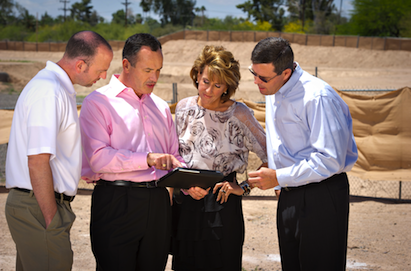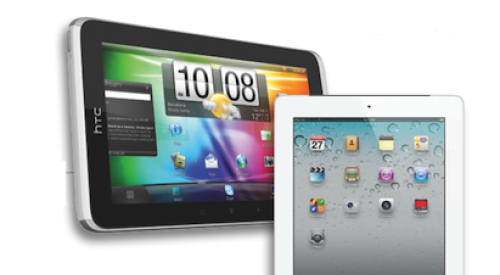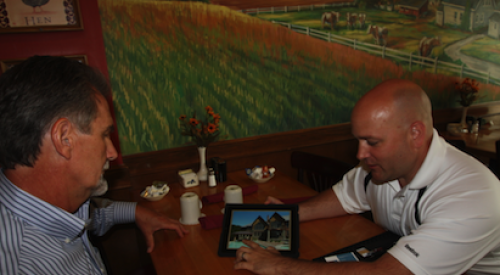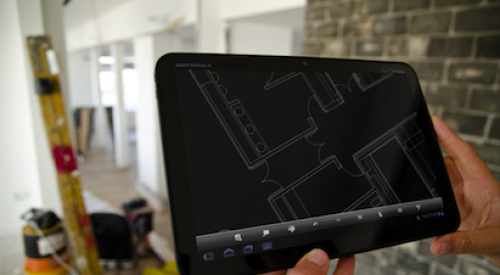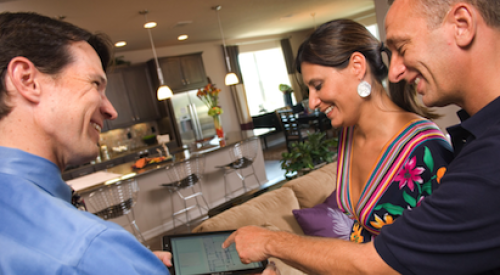Dan Verdoorn admits he wasn’t an “Apple guy” until about year and a half ago, when the buzz surrounding the debut of the iPad intrigued him enough to purchase one for his business. Less than six months later, he purchased the Apple tablets for his entire management team, and now his company uses iPads for “just about everything” — from accessing plans in the field to handling change orders to sketching design ideas for clients.
“I used to carry 40 lbs. of rolled-up plans in the back of my truck,” says Verdoorn, co-owner of Celebrity Custom Homes, Englewood, Colo., a second-generation builder of custom and semi-custom homes in the Denver area. “Now I have everything I need — every contract, every specification sheet, full sets of plans — all on my iPad. I rank it up there with CAD, fax machines, and cell phones as one of the most important business tools in the past 30 years. I find new uses for my iPad every day.”
Tablet Report Contents
Exclusive Research
Tablets on the Jobsite
Designing with Tablets
Using Tablets to Market and Sell Homes
Product Review: Which Tablet is Right for You?
99 Tablet Apps Made for Builders
Verdoorn’s latest iPad discovery is one that has grabbed headlines for the builder — he is equipping his new model homes with the devices to serve as the user interface for the home automation system. His “iPad homes” are not just a marketing tactic — the builder found the iPad to be a far superior (and cheaper) user interface than comparably sized LCD home automation touch screens on the market (see sidebar below).
Verdoorn’s adoption of tablet PCs as a core business tool is becoming a familiar story in the home-building industry. Builders across the country are turning to tablet technology at a growing rate — and for a host of business applications. There’s Bonita Springs, Fla.-based WCI Communities, which is giving away iPads to its buyers fully loaded with homeownership manuals, warrantees, and related material, as well as the builder’s custom iPad app. There’s Sivage Homes of Albuqueque, N.M., which has made tablets the focal point of its sales center and model home tours (the builder’s sales team is so effective with the devices that it has been able to forgo the construction of additional model homes, saving hundreds of thousands of dollars). And then there’s Augusta, Ga.-based Keystone Homes, which manages nearly every step of the construction process with the help of tablet technology.
The rate of tablet adoption among home builders is quite astounding, especially considering the first-generation iPad launched just 17 months ago. In a July 2011 survey of nearly 700 Professional Builder readers, more than one in three builders (35 percent) said they currently own a tablet PC, and about half (49 percent) said they are planning to purchase a tablet device for their business.
Of the current tablet owners, nearly 93 percent said they use it for business use. The most popular business functions, according to survey respondents, are email, web browsing, office tasks, field operations, sales presentations, and social media (see charts).



Why tablets now?
According to our exclusive research, builders are adopting tablet technology for a variety of reasons. First, the large 7- to 10-inch, high-definition touch-screen monitor allows users to easily view and work with plans, elevations, photos, and other documentation. These devices are light, extremely portable, and they boot up in seconds, allowing users to work anywhere without delay. The built-in GPS allows for a variety of useful tasks — from real-time mapping to surface leveling — and the video/photo cameras and players are great for troubleshooting jobsite issues, conducting remote meetings, and sales presentations. Then there are the thousands of applications available to tablet users — everything from construction calculators and sketch programs to credit-card swipe technology and contract form programs — all one click away and for minimal cost.
“It’s the versatility and portability that make the tablet such an effective tool,” says Graham Hughes, VP of sales and marketing with Taylor Morrison, Scottsdale, Ariz. “I can travel to one of our divisions, say Austin, Texas, and I’ll use my iPad for navigation to find the community, and when I’m talking with the sales team I can tap into our company reporting system and pull up real-time reports on sales and traffic. It’s all at my fingertips.”
Hughes says another big plus is the ability for the iPad to sync with Taylor Morrison’s enterprise system. “The security is now such that our IT team is happy with us utilizing iPads and iPhones in terms of linking into email and our Windows-based desktops,” he says. Using a third-party iPad app, Hughes can gain access to his desktop computer remotely in seconds, where he can call up all company files and reports. “This is what made the iPad something I purchased for portable use into something I use for work every single day,” says Hughes.
These are just a few examples of how builders are using tablet computers to make their business and personal lives easier. Many more are featured in our special tablet report, which continues with break-out stories on how home-building professionals are using the technology to manage jobsite operations, market and sell new homes, and tackle design-related tasks. We wrap up our report with an in-depth review of the latest tablet devices, followed by a collection of 99 tablet apps that are taylor made for home-building professionals.
Denver builder makes iPads the brains of its new homes

Builder Dan Verdoorn demonstrates the iPad-controlled home automation system running his new model in Lone Tree, Colo.
The latest color LCD monitors for home automation systems are nice, but Denver-area builder Dan Verdoorn has discovered a far superior (and cheaper) user-interface solution — Apple’s iPad. The second-generation builder of custom and semi-custom homes recently equipped a model home in his Overlook in Lone Tree community with two built-in iPads that can control everything from the lights, security system, and motorized shades to the audio/visual and closed-circuit camera system.
Using the Crestron Mobile Pro G app ($99), the iPads can control any device or system in the home that is connected to the Crestron home-automation platform. The iPads are docked on the wall but can be removed and used anywhere inside or outside the home.
“The iPads are great because homeowners can customize their system any way they want, using the various apps on the market,” says Verdoorn, co-owner of Celebrity Custom Homes, Englewood, Colo.
“For instance, there’s even an app for baby monitor cameras that allow you to watch your baby from the iPad or your iPhone, so you can go across the street for a cup of coffee with your neighbor and you’ll know that your baby is sleeping.”
Another plus of the Apple platform is that owners can also use their iPhone or iPod touch devices to control the home automation system. And, because they work off the home’s Wi-Fi network, no proprietary wiring is required. Moreover, at $500, the iPad is a fraction of the cost of some of the in-wall touch-screen monitors, which can cost upwards of $3,000.
While Verdoorn admits that his iPad-controlled home concept has yet to directly result in a sale, the popularity and versatility of the iPad has certainly attracted attention to his new community, especially among Apple enthusiasts.
“I just completed a home for a definite ‘Mac head,’” he says. “He’s got Apple everything. And now he has an Apple-controlled home.”
Survey Methodology
This survey was distributed on July 19, 2011, to 86,054 Professional Builder readers. three $50 gift certificates were offered to randomly selected respondents as incentive. By the closing date of July 29, a total of 695 eligible readers had responded. sixty-one percent of respondents identified themselves as a single-family home builder; 11.7 percent designer/architect; 2.7 percent multi-family builder; 2.6 percent systems builder; and 22.0 percent “other.”
